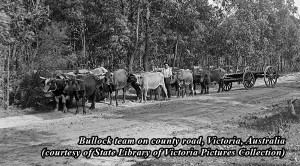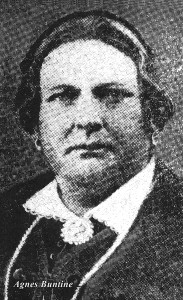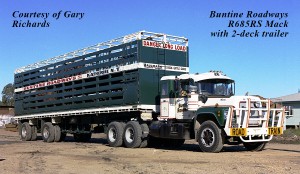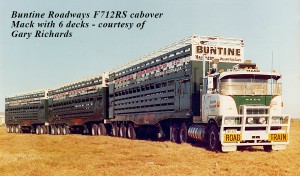 I know they breed them tough in Glasgow, so I should not have been surprised when I heard about Agnes Buntine. Once, in the 1860s, in the Queensland mining town of Bald Hills in Australia, someone took a bull-whip to a man who had “pawed” a young girl, and “thrashed him nearly sober.” The dude with the whip wasn’t Clint Eastwood – it was Agnes, a transportation pioneer in Australia. Agnes could have graced the front row of any self-respecting rugby team – she was tough. And if society expected her to be a wilting flower on some man’s arm, well, they hadn’t checked with Agnes first.
I know they breed them tough in Glasgow, so I should not have been surprised when I heard about Agnes Buntine. Once, in the 1860s, in the Queensland mining town of Bald Hills in Australia, someone took a bull-whip to a man who had “pawed” a young girl, and “thrashed him nearly sober.” The dude with the whip wasn’t Clint Eastwood – it was Agnes, a transportation pioneer in Australia. Agnes could have graced the front row of any self-respecting rugby team – she was tough. And if society expected her to be a wilting flower on some man’s arm, well, they hadn’t checked with Agnes first.
Born in Glasgow, Scotland in 1822, Agnes Davidson went to Australia at the age of 18 in 1840 and worked as a dairymaid, marrying Scot Hugh Buntine that year, too. They added six children to the five he had from his first marriage (his first wife had died of typhoid on the voyage out), and headed for the hills of Gippsland in Victoria (near Australia’s extreme southeast), where the forests and mountains had defeated many explorers, to carve out a living. They ran a pub, the Bush Inn, for three years, then a general store. Hugh, ill himself, even “began helping the sick and injured and became known as Dr. Buntine,” wrote Patsy Adam-Smith in Outback Heroes.
 Agnes decided to start a carting (delivery) business. Back then, deliveries were made by teams of oxen pulling a wagon called a bullock train – there were no trucks, yet. It was 20 years later when a man named J.J. O’Connor walked, wet and cold, into a pub at Toongabbie, a small town in southeastern Victoria on the way to the gold fields, after driving cattle all day. “I saw a boiling kettle on the fire, and thought a hot whiskey would be fine,” he said. “Just then, in walked this great big, rough-looking woman and the landlord introduced me.” It was Agnes, and she was wet and cold, too. “Being the only guests, we sat all evening by the fire. She didn’t boast of anything she had done beyond rearing her children. I asked why she took up bullock-driving, and she said she had to keep her family, and as men were making good money at the carrying trade, she thought she could do the same.” And she did.
Agnes decided to start a carting (delivery) business. Back then, deliveries were made by teams of oxen pulling a wagon called a bullock train – there were no trucks, yet. It was 20 years later when a man named J.J. O’Connor walked, wet and cold, into a pub at Toongabbie, a small town in southeastern Victoria on the way to the gold fields, after driving cattle all day. “I saw a boiling kettle on the fire, and thought a hot whiskey would be fine,” he said. “Just then, in walked this great big, rough-looking woman and the landlord introduced me.” It was Agnes, and she was wet and cold, too. “Being the only guests, we sat all evening by the fire. She didn’t boast of anything she had done beyond rearing her children. I asked why she took up bullock-driving, and she said she had to keep her family, and as men were making good money at the carrying trade, she thought she could do the same.” And she did.
In 1851, Agnes drove a bullock train, single-handedly, from southern Victoria over ‘The Great Divide’ – now known as The Great Dividing Range or Australian Alps, it is Australia’s biggest mountain range and the third longest in the world – to the gold fields over 120 miles away. “Her cargo was one ton of cheese and half a ton of butter,” wrote Adam-Smith, and she carried a rifle. When she arrived, she opened two stores and a third when another gold rush began elsewhere that caused the local population to soar from 23,000 to half a million in six years. Diggers started seeing her as a reliable carrier between them and Melbourne. They knew that Agnes would get it done, despite the weather or terrain. A typical trip from Melbourne was by sea to Port Albert, then bullock train, and finally, pack-horses into the mountains. Agnes was often the first to get to what were then considered ‘inaccessible’ places.
As well as handling horses and bullocks, Agnes could ride, kill and dress a bullock, split timbers and make fencing. She was as at home with a pick and shovel as she was with a whip. They called her Mother Buntine. In 1863, she almost died while fighting to save her wagons and freight from a bush fire. Hugh died in 1867. Six years later she married Michael Hallett and took up farming.
There were three known female bullock drivers in Australia during this pioneer period – and all of them were Scots. One did it just to move her six children and household possessions from one place to another, after her husband died. Another was Margaret McTavish. Her father beat her for not riding side-saddle, and she ran away to live with aborigines for a month. He tracked her down and burned her feet with a hot iron. At 14, she dressed as a boy, called herself Tommy, and became a bullocky’s offside (a type of apprentice) and horse breaker. Her disguise was so good that her father once passed her on the street and didn’t recognize her. When she got injured, people found out she was a girl, but her boss refused to believe it, saying, “A better chum had never existed.” She eventually gave up that rough life, got married, and then had seven children.
 As for Agnes, her carting business went on for the whole of her life, until her death at the age of 74 in 1896. Would it, or could it, begin all over again, the people of Victoria, who had come to rely on her, must have wondered? She had arrived with a vengeance, and ruled the roost for more than three decades. It was pretty quiet after she’d gone, with her children going into every walk of life but the transportation business.
As for Agnes, her carting business went on for the whole of her life, until her death at the age of 74 in 1896. Would it, or could it, begin all over again, the people of Victoria, who had come to rely on her, must have wondered? She had arrived with a vengeance, and ruled the roost for more than three decades. It was pretty quiet after she’d gone, with her children going into every walk of life but the transportation business.
But, 100 years after Agnes started, out of the blue came another Buntine, her great-great-grandson Noel who, at the same age she had been, started a transport business in the Northern Territory called Buntine Roadways. It was Agnes all over again. At a time when cattle were still being moved overland by drovers, he started moving them through the harsh outback by truck. Noel Buntine showed the same family staying power displayed by his grandmother, Agnes, as well as his mother, Iris Buntine, who was a telephone exchange operator in western Queensland for 50 years, which, in 1975, she received a British Empire Medal from the Queen for her service.
 Starting in 1953, “Noel moved 3,600 cattle in his first year,” according to Australia’s N.T. Auto News. “Later, he had equipment capable of moving that number in a single operation.” Some years ago I spoke to Noel’s son, Dennis (who passed away in March 2013), a Volvo truck dealer in Darwin, and his wife Lorraine, who told me that before long, “Noel was running the biggest road train outfit in the southern hemisphere.” By the 1980s, Noel had 50 road trains, each more than 50 meters long (165 feet), carrying stock throughout the Northern Territory, northern South Australia and Queensland. He sold the business 20 years ago, but others kept it going. He’d put in his 30 years, as Agnes had.
Starting in 1953, “Noel moved 3,600 cattle in his first year,” according to Australia’s N.T. Auto News. “Later, he had equipment capable of moving that number in a single operation.” Some years ago I spoke to Noel’s son, Dennis (who passed away in March 2013), a Volvo truck dealer in Darwin, and his wife Lorraine, who told me that before long, “Noel was running the biggest road train outfit in the southern hemisphere.” By the 1980s, Noel had 50 road trains, each more than 50 meters long (165 feet), carrying stock throughout the Northern Territory, northern South Australia and Queensland. He sold the business 20 years ago, but others kept it going. He’d put in his 30 years, as Agnes had.
The fact that many country towns in Australia are placed a day’s bullock drive apart may be lost on today’s Hertz-driving tourists who can do it in 20 minutes. Still, for those who do the opposite, and drive along in the outback, dreaming sentimentally about the past bullock trains and famous bullocky’s like Agnes Buntine, there is nothing quite like a long and loud road train of trucks and trailers overtaking you on the road to bring you back to the present.

1 Comment
I’m looking for any info on Leo who had cattle truckings in Wyndham. Any pics or history would be great. He moved to Perth eventually when he got ill. He’s wife/partner was Ronnie from Brecon, Wales, UK.